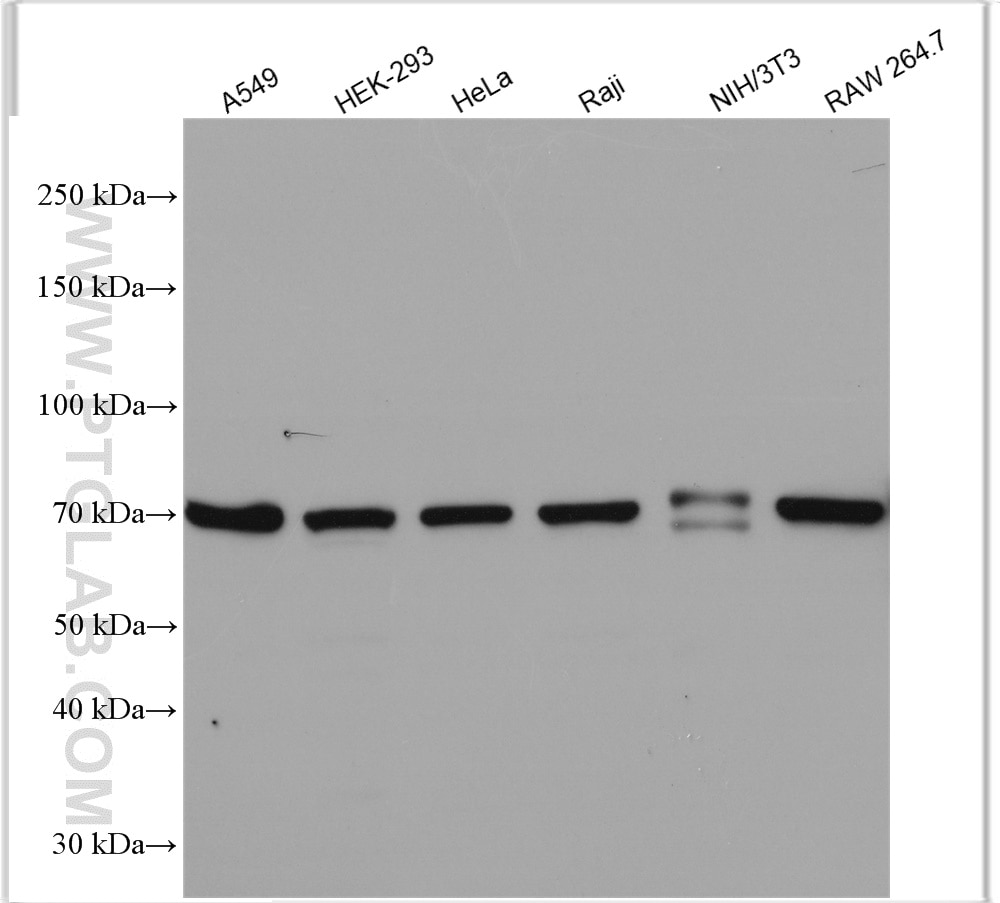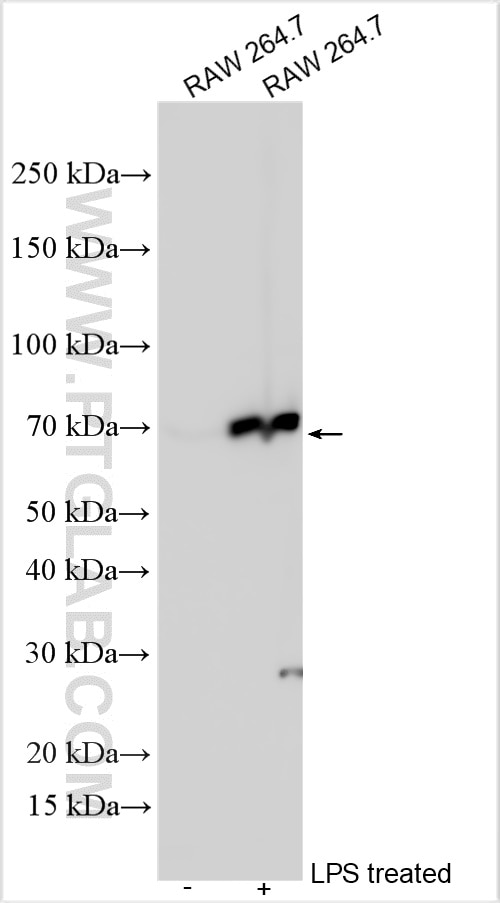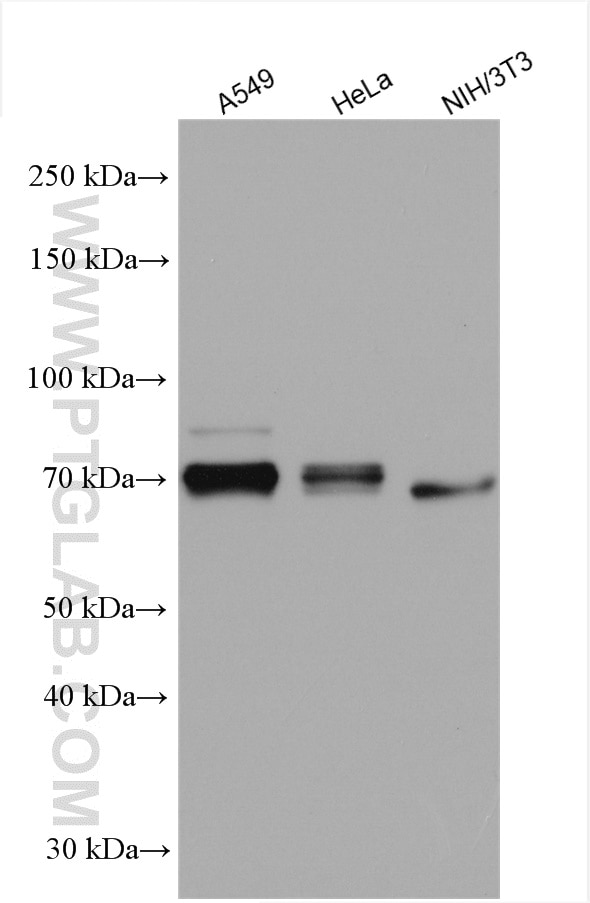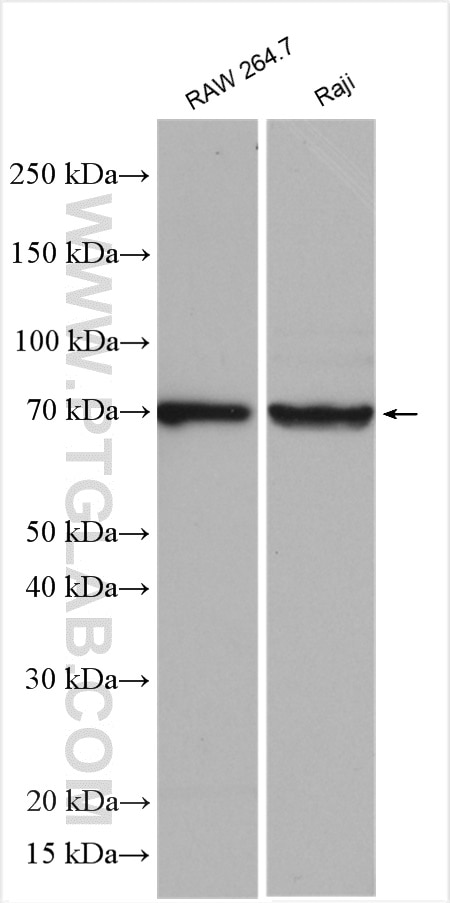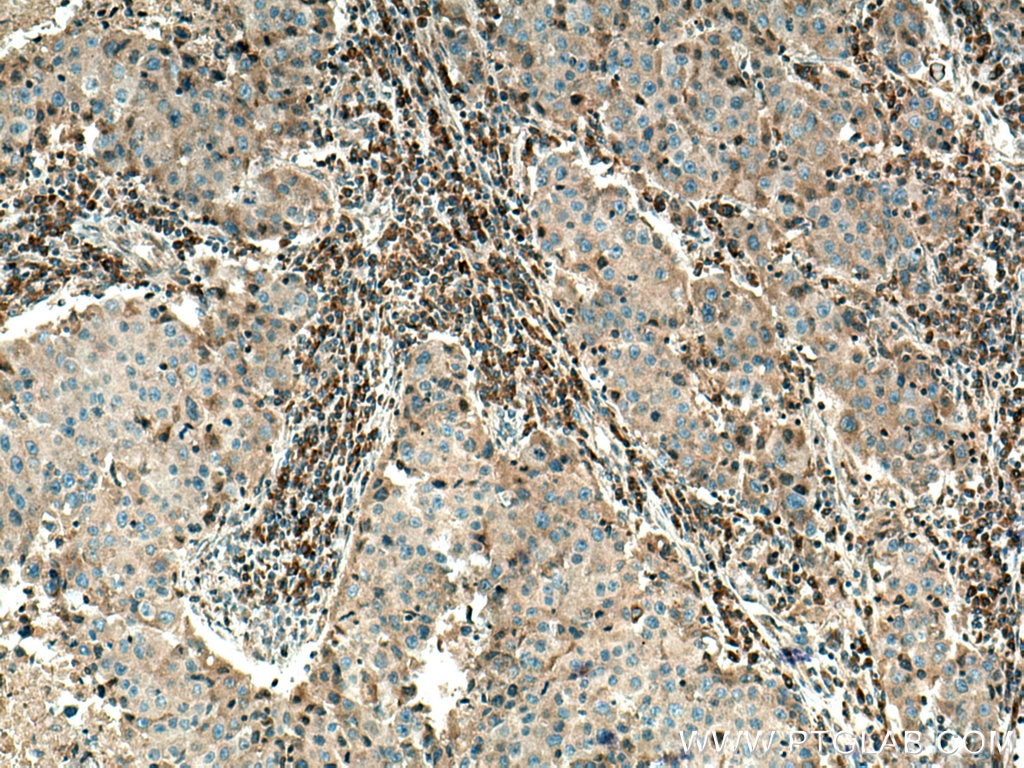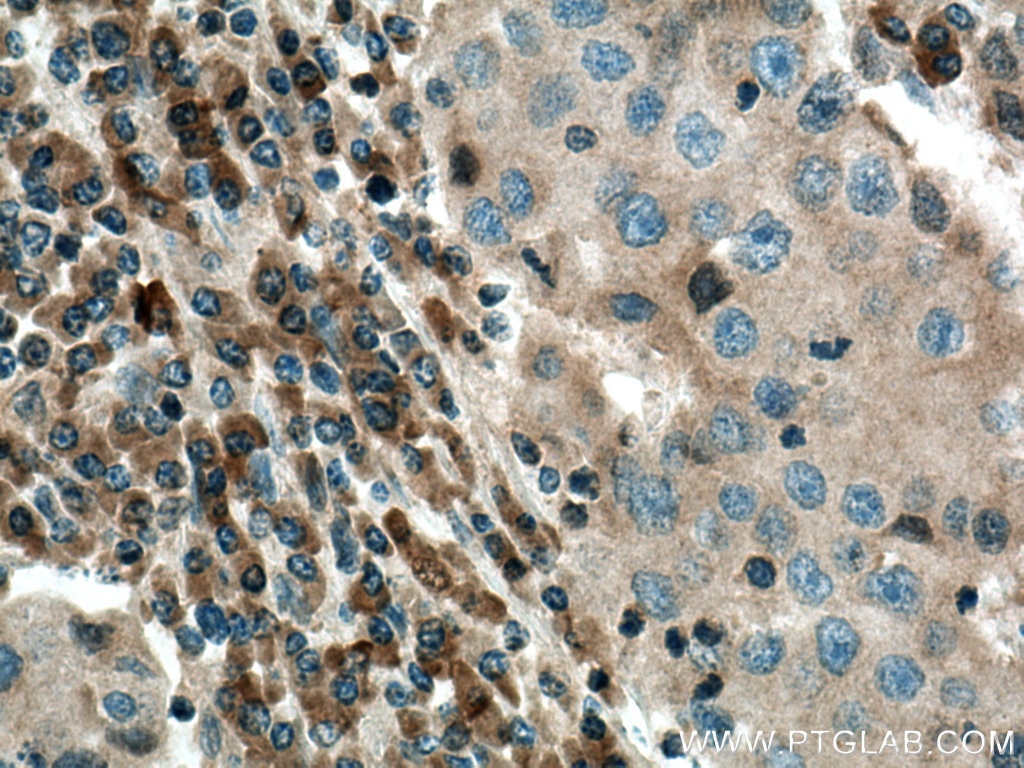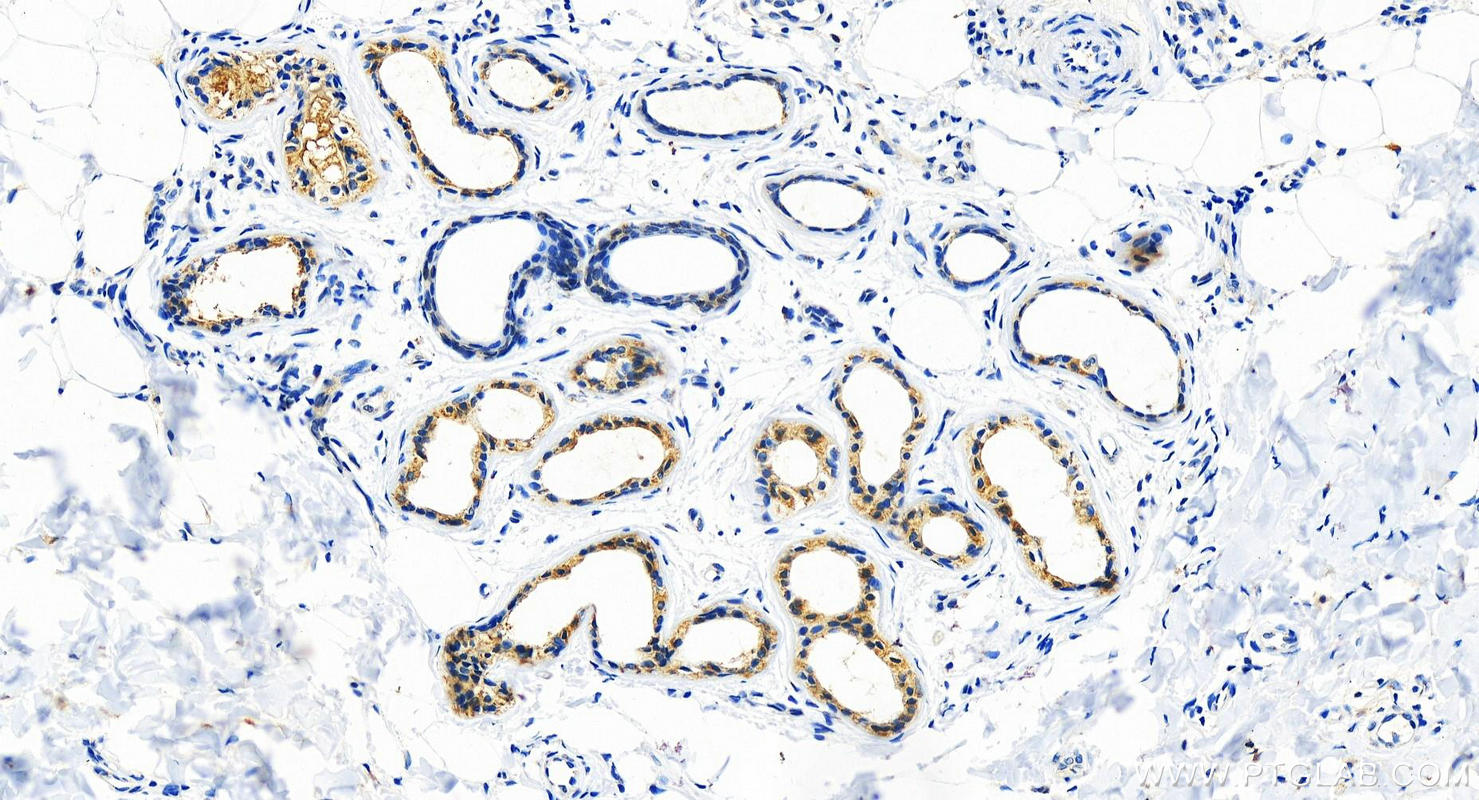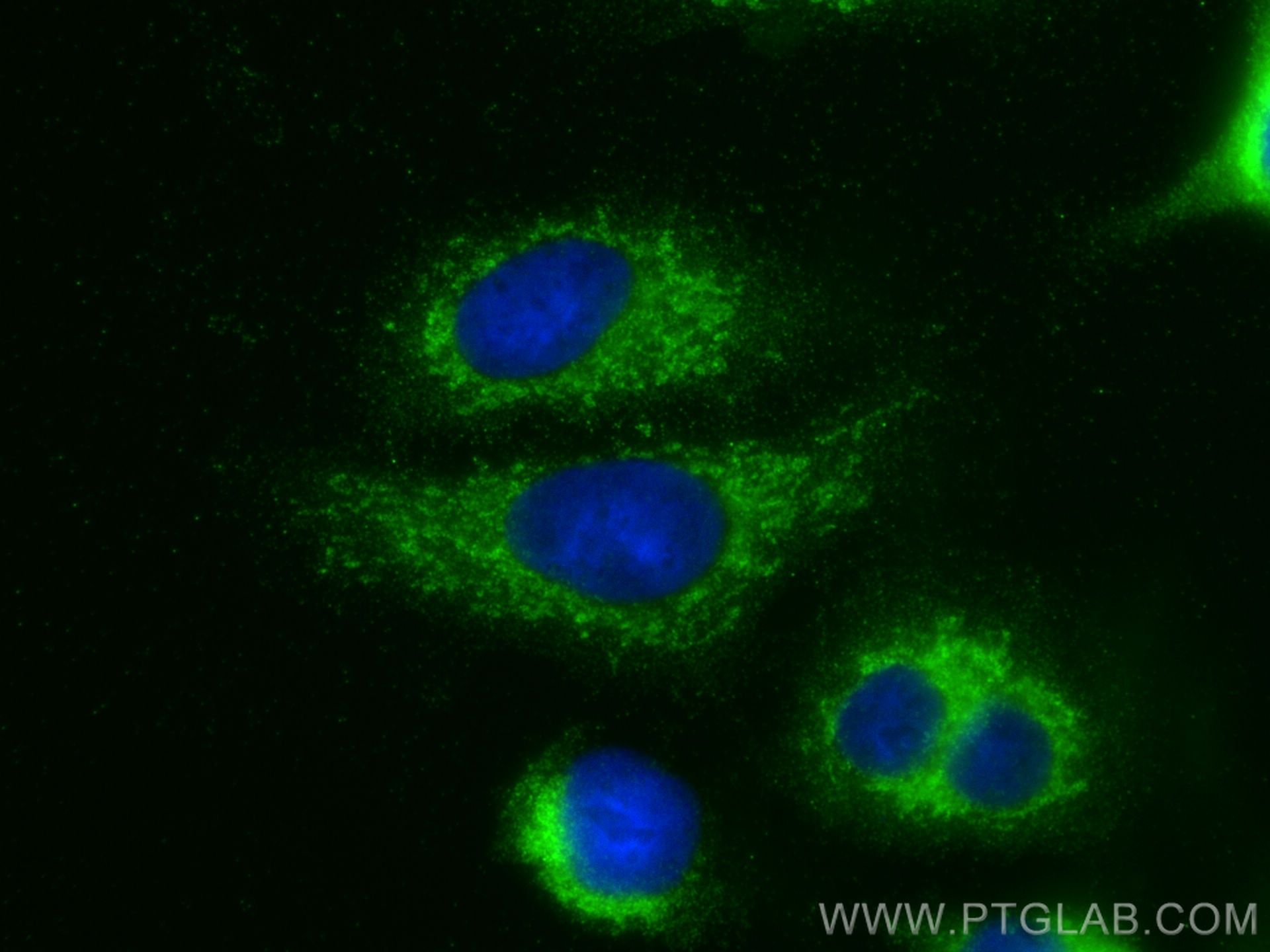Tested Applications
| Positive WB detected in | A549 cells, RAW 264.7 cells, HeLa cells, NIH/3T3 cells, HEK-293 cells, Raji cells |
| Positive IHC detected in | human breast cancer tissue Note: suggested antigen retrieval with TE buffer pH 9.0; (*) Alternatively, antigen retrieval may be performed with citrate buffer pH 6.0 |
| Positive IF/ICC detected in | A549 cells |
COX-2 expression is undetectable in most normal tissues but dramatically upregulated during inflammation (PMID: 9249646, 18657230).
Recommended dilution
| Application | Dilution |
|---|---|
| Western Blot (WB) | WB : 1:1000-1:4000 |
| Immunohistochemistry (IHC) | IHC : 1:50-1:500 |
| Immunofluorescence (IF)/ICC | IF/ICC : 1:200-1:800 |
| It is recommended that this reagent should be titrated in each testing system to obtain optimal results. | |
| Sample-dependent, Check data in validation data gallery. | |
Published Applications
| KD/KO | See 1 publications below |
| WB | See 427 publications below |
| IHC | See 44 publications below |
| IF | See 27 publications below |
| CoIP | See 1 publications below |
Product Information
12375-1-AP targets COX2/ Cyclooxygenase 2/ PTGS2 in WB, IHC, IF/ICC, CoIP, ELISA applications and shows reactivity with human, mouse samples.
| Tested Reactivity | human, mouse |
| Cited Reactivity | human, mouse, rat, pig, chicken |
| Host / Isotype | Rabbit / IgG |
| Class | Polyclonal |
| Type | Antibody |
| Immunogen |
CatNo: Ag3025 Product name: Recombinant human COX2/ Cyclooxygenase 2 protein Source: e coli.-derived, PGEX-4T Tag: GST Domain: 20-366 aa of BC013734 Sequence: PCCSHPCQNRGVCMSVGFDQYKCDCTRTGFYGENCSTPEFLTRIKLFLKPTPNTVHYILTHFKGFWNVVNNIPFLRNAIMSYVLTSRSHLIDSPPTYNADYGYKSWEAFSNLSYYTRALPPVPDDCPTPLGVKGKKQLPDSNEIVEKLLLRRKFIPDPQGSNMMFAFFAQHFTHQFFKTDHKRGPAFTNGLGHGVDLNHIYGETLARQRKLRLFKDGKMKYQIIDGEMYPPTVKDTQAEMIYPPQVPEHLRFAVGQEVFGLVPGLMMYATIWLREHNRVCDVLKQEHPEWGDEQLFQTSRLILIGETIKIVIEDYVQHLSGYHFKLKFDPELLFNKQFQYQNRIAAE Predict reactive species |
| Full Name | prostaglandin-endoperoxide synthase 2 (prostaglandin G/H synthase and cyclooxygenase) |
| Calculated Molecular Weight | 604 aa, 68 kDa |
| Observed Molecular Weight | 70-74 kDa |
| GenBank Accession Number | BC013734 |
| Gene Symbol | COX2/PTGS2 |
| Gene ID (NCBI) | 5743 |
| RRID | AB_2085127 |
| Conjugate | Unconjugated |
| Form | Liquid |
| Purification Method | Antigen affinity purification |
| UNIPROT ID | P35354 |
| Storage Buffer | PBS with 0.02% sodium azide and 50% glycerol, pH 7.3. |
| Storage Conditions | Store at -20°C. Stable for one year after shipment. Aliquoting is unnecessary for -20oC storage. 20ul sizes contain 0.1% BSA. |
Background Information
COX2 is an enzyme involved in the synthesis of prostaglandins from arachidonic acid.
1. What is the molecular weight of COX2?
The fully N-glycosylated PTGS2 is 72-74 kDa and the aglycosylated is 66 kDa (PMID:19656660). It also
expresses a band of 39 kDa after unspecific cleavage (PMID:17509125). The 50 kDa band of fragmented
PTGS2 has also previously been detected in AD brains (PMID:14724276).
2. Is COX2 post-translationally modified?
COX2 is a subject of post-translational modifications, including phosphorylation, glycosylation, and
s-nitrosylation (PMID: 28939645).
3. What is the difference between COX1, COX2, and COX3?
There are three isoenzymes that have cyclooxygenase activity: COX1, COX2, and COX3. While COX1
is a ubiquitously expressed constitutive enzyme, expression of COX2 is generally low but can be rapidly
induced by various stimuli (as part of infection and inflammatory response) and is controlled by the
transcription factor NFκB. COX3 is an alternative splice variant of COX1 enzyme and is considered
non-functional in humans.
4. I cannot detect COX2 in my sample during western blotting.
Unlike COX1, COX2 expression is inducible by a variety of stimuli including certain growth factors, cytokines,
and proinflammatory stimuli. COX2 basal expression levels may be very low in unstimulated cells. Additionally,
the COX2 half-life time is short and after stimulation, COX2 protein can be quickly degraded to basal levels
(PMID: 10966456), which should be taken into account during experimental design.
5. What is the role of COX2 in cancer?
COX2 is often upregulated in various cancer types and increased expression of COX2 is associated with
greater angiogenesis of solid tumors, increased invasion, and metastasis, as well as decreased host immunity.
6. What is subcellular localization of COX2?
Both COX1 and COX2 are present in the endoplasmic reticulum (ER) and nuclear envelope (PMID: 9545330),
but COX2 has been reported to be more enriched in the nuclear envelope compared to COX1 (PMID: 7738031).
Protocols
| Product Specific Protocols | |
|---|---|
| IF protocol for COX2/ Cyclooxygenase 2/ PTGS2 antibody 12375-1-AP | Download protocol |
| IHC protocol for COX2/ Cyclooxygenase 2/ PTGS2 antibody 12375-1-AP | Download protocol |
| WB protocol for COX2/ Cyclooxygenase 2/ PTGS2 antibody 12375-1-AP | Download protocol |
| Standard Protocols | |
|---|---|
| Click here to view our Standard Protocols |
Publications
| Species | Application | Title |
|---|---|---|
Adv Sci (Weinh) 3D Printing of a Vascularized Mini-Liver Based on the Size-Dependent Functional Enhancements of Cell Spheroids for Rescue of Liver Failure | ||
Sci Adv An annular corneal microneedle patch for minimally invasive ophthalmic drug delivery | ||
Bone Res Piezo1 expression in chondrocytes controls endochondral ossification and osteoarthritis development | ||
Nat Commun BNC1 deficiency-triggered ferroptosis through the NF2-YAP pathway induces primary ovarian insufficiency | ||
EBioMedicine Clearance of apoptotic cells by mesenchymal stem cells contributes to immunosuppression via PGE2. | ||
EBioMedicine Up-regulated FHL2 inhibits ovulation through interacting with androgen receptor and ERK1/2 in polycystic ovary syndrome. |
Reviews
The reviews below have been submitted by verified Proteintech customers who received an incentive for providing their feedback.
FH Uthra (Verified Customer) (10-04-2022) | Paraffin-IHC from embedded mouse skin
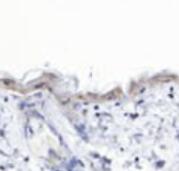 |
FH Reema (Verified Customer) (09-07-2022) | The antibody works perfectly with WB
|
FH Lena (Verified Customer) (02-21-2022) | Used for Paraffin-IHC from embedded mouse bones
|
FH Ryan (Verified Customer) (02-28-2019) | Tissue was fixed in PFA and no further antigen retrieval was necessary. Co-localisation in microglia shown with a known marker (magenta).
 |

